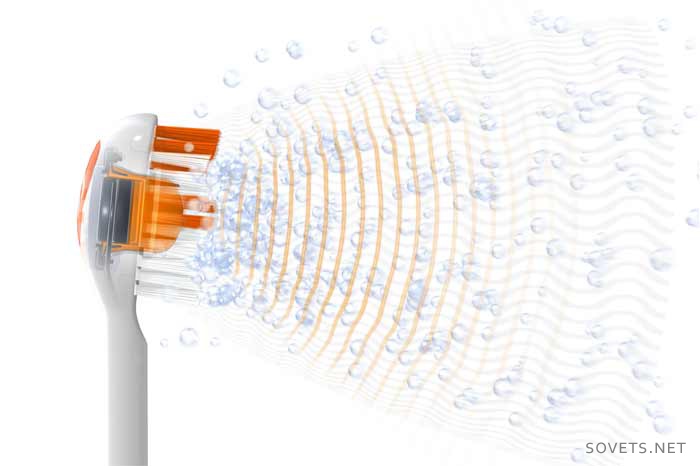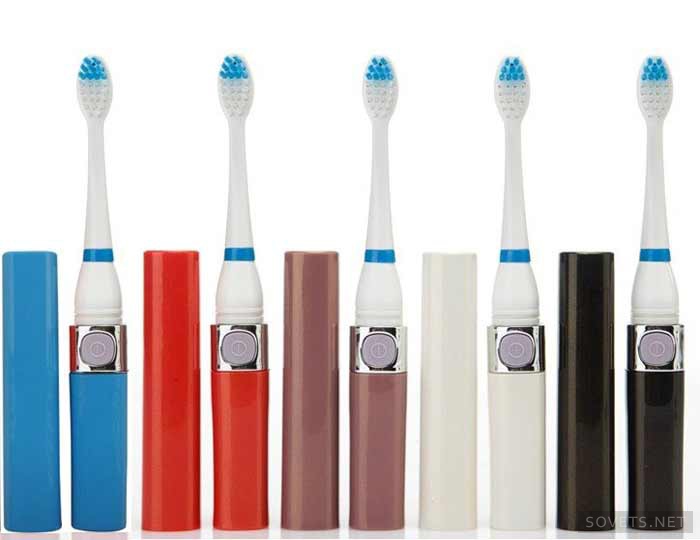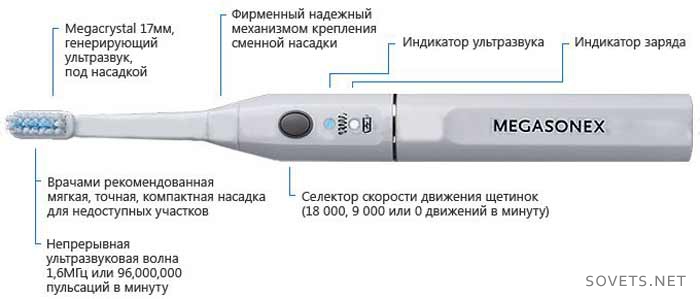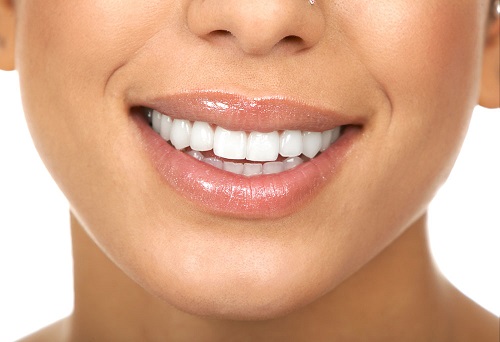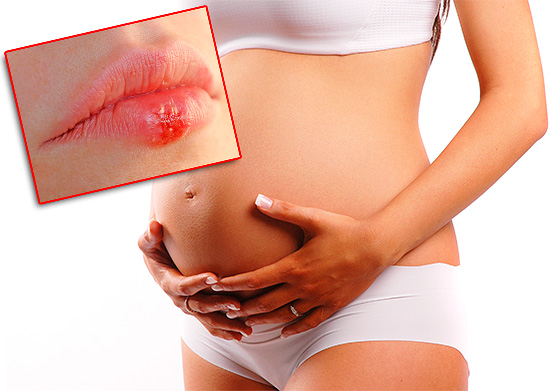Content
- What is an ultrasonic brush
- Ultrasonic Brush Efficiency
- When not to use a brush?
- Choose a purchase
- How to use an ultrasonic brush
- How much is an ultrasonic brush?
- Why ultrasound, not electric?
- What dentists advise?
Daily brushing provides the right degree of cleanliness and protects teeth from pathogenic bacteria. You can brush your teeth with ordinary brushes, electric, or you can try such a novelty as an ultrasonic toothbrush. What are the features of this gadget, and how to use it? Having dealt with this issue, you will surely change the usual brush to the one that creates ultrasound.
What is an ultrasonic brush
Sound vibrations in the ultrasound range are created by the motor. Its main component is a piezoelectric element. Due to it, electric energy becomes mechanical, and energy consumption remains minimal. This explains the long-term operation of the brush, even on batteries or rechargeable batteries..
So, the microprocessor creates mechanical energy, which is transmitted to the plate and provokes vibration of the brush. The vibrational wavelength is such that the pulse propagates to a length of not more than 4 mm from the bristles.
There is a huge selection of models. Some of them combine ultrasonic vibrations and sound waves. Rotations can also be added, although there is no particular need for them, because ultrasound independently eliminates all dental deposits without mechanical cleaning. Almost all models have a time sensor, which after 30 seconds gives an audible signal, which is time to move on to processing another part of the jaw.
Ultrasonic Brush Efficiency
During tooth treatment with an ultrasonic brush, the temperature of the tissues rises by 1-1.5 degrees. Due to this, all processes proceed much faster. It is important that due to the heat the blood vessels expand, which means that the microcirculation of the tissues of the oral cavity improves.
This design improves the absorption of nutrients that are found in mouthwashes, balms and toothpastes. The frequency of oscillations ensures the removal of not only food plaque, but also tobacco.
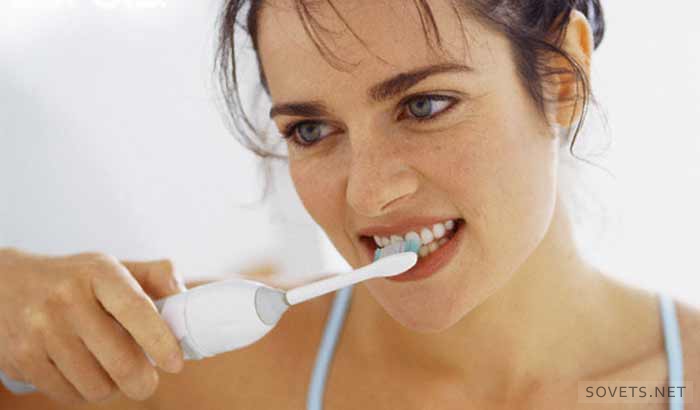
Such cleaning is also useful for the oral mucosa. With proper use, there is a decrease in pain, spasms are removed, and scars after tooth extraction and transferred gum disease resolve.
When not to use a brush?
An ultrasonic toothbrush has its contraindications. To begin with, the service life of filling material, crowns, braces, and veneers is reduced due to the impact of ultrasound on them. This is due to the fact that in the dental tissue and in the filling, the waves propagate with different strengths.
Such a brush is contraindicated in patients with problems of the gums and ligaments of the teeth. In particular, the owners of periodontitis, periodontal disease, gingivitis, periodontitis and other similar diseases. This is because vibration and improved blood circulation can contribute to the penetration of the infection, which caused inflammation, into the deeper layers of the periodontium..
If there are no such diseases yet, but you notice bleeding gums, swelling of the mucous membrane and pain during brushing with an ordinary brush, you need to abandon the ultrasonic brush and go to the dentist to determine the causes of this condition. Enamel weakness, which you can determine from the photo (whitish spots appear on the teeth), is also regarded as a contraindication to the use of an ultrasonic brush.
As for vibration, it is undesirable in the presence of intra-maxillary structures, such as implants and pins. Removable prostheses are not considered a contraindication.
Choose a purchase
What to look for when buying an ultrasonic brush? The market represents a large number of good models. These are Emmi dent, HSD 005, Omron, Philips, Smilex Vitesse and so on. First of all, we look at the appearance of the brush. Next, we evaluate the shape of the head and the convenience of holding it in the hand.
Give preference to artificial materials, because they are more durable. Some models have a time indicator and a timer. It is important to have power and recharge. The rest you can rely only on your taste.
How to use an ultrasonic brush
After acquiring a brush and reading the instructions, proceed to brushing your teeth. To do this, turn on the brush and begin to process the surface of the teeth. For convenience, divide the dentition into six sections. Due to the presence of a timer, you can adjust the exposure time of the brush.
After cleaning, rinse the brush head thoroughly and dry it. As a result of such treatment, plaque will not remain on the teeth even in hard-to-reach places, and tartar after a few cleanings will begin to decrease in size, which will be an excellent prevention of caries.
How much is an ultrasonic brush?
The price range of brushes is incredibly wide. The price directly depends on the manufacturer, as well as on the configuration. Reasonably priced is the Sonik Ultra device. A bit more expensive you can buy Sonic Toothbrush Color Focus TB 001, Braun Oral B Sonic Complete, Donfeel and Ultrasonic.
These are the famous Megasonex, Water Peek SR 3000 and Sonicare brushes. But for the best Ultrasonex brushes have to pay a large sum of money.
Why ultrasound, not electric?
Unlike electric toothbrushes, ultrasonic ones are able to remove plaque in the most inaccessible places, especially in the spaces between crowded teeth.
But ultrasonic toothbrushes have significantly more contraindications than electric ones, and if you have healthy teeth, the first one will help to maintain their health, providing perfect hygiene.
What dentists advise?
Doctors say that people with arterial hypertension, oncological formations, neurology, blood clotting disorders, and so on should not use such a brush. Dentists advise to refrain from this brush in the presence of diseases of the oral cavity in the acute stage.
Pay special attention to the price. No need to take a cheap model. Remember that improperly selected ultrasound can affect the tissue destructively, which means that there will be no benefit from such cleaning.






